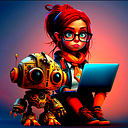Level Up: How I Transitioned from Product Design
to a Strategic Product Leader
Supporting Heart Area❤️
(✔) Introduction
Many talented UX/UI designers dream of taking the next step in their careers and becoming strategic product leaders. It’s a natural progression that allows you to leverage your design expertise while influencing the product roadmap and shaping the overall user experience. But how do you make that leap? In this blog post, I’ll share my personal journey, highlighting the key skills I developed and the experiences I sought to bridge the gap from product design to strategic product leadership.
() Expanding Your Knowledge Base
The transition requires a shift in focus. While design skills remain crucial, strategic leadership demands a broader understanding of the business. Here’s what I did to expand my knowledge:
- Business Acumen: I familiarized myself with business metrics, financial statements, and competitive analysis. This allowed me to speak the language of stakeholders and understand the product’s impact on the bottom line.
- Product Strategy: I delved deeper into product strategy frameworks and roadmapping methodologies. This equipped me to think beyond individual features and consider the product’s long-term vision.
- User Research Fundamentals: While design leans heavily on user research, I broadened my understanding of quantitative research methods to gain a more holistic view of user needs.
(⚙️) Building Strategic Thinking
Strategic thinking is a core competency for product leadership. Here’s how I honed it:
- Asking “Why?”: I trained myself to go beyond the “what” and “how” of features and delve into the “why.” This involved asking questions about business goals, user motivations, and potential risks and rewards.
- Thinking Long-Term: I shifted my focus from short-term design wins to long-term product vision. I practiced considering market trends, competitor analysis, and future user needs.
- Prioritization: Effective product leaders excel at prioritizing tasks and initiatives. I actively participated in cross-functional discussions, learned to weigh different perspectives, and advocate for the most impactful solutions.
() Developing Leadership Skills
Leadership goes beyond technical expertise. Here are some leadership skills I nurtured:
- Communication: I honed my communication skills to clearly articulate complex ideas to both technical and non-technical audiences. This involved tailoring my message to different stakeholders and ensuring everyone understood the vision.
- Collaboration: Product leadership thrives on collaboration. I actively fostered strong relationships with cross-functional teams, including engineering, marketing, and sales. This built trust and ensured everyone worked towards shared goals.
- Mentorship: Mentoring junior designers allowed me to share my knowledge and develop leadership skills.
() Building Your Network
Building strong relationships is crucial for success in any leadership role. Here’s how I cultivated a valuable network:
- Internal Networking: I actively participated in cross-functional meetings and offered my design expertise beyond my immediate team. This increased my visibility and helped me build relationships with key stakeholders.
- External Networking: I attended industry events and conferences, connecting with other product leaders and staying abreast of industry trends.
() Conclusion
The transition from product design to strategic product leadership is a journey, not a destination. It requires continuous learning, skill development, and a willingness to shift your perspective. But for those who embrace the challenge, the rewards are immense. You get to shape the future of your product, lead a talented team, and make a significant impact on your organization’s success.
I hope my story inspires you to level up your own career. Remember, the journey starts with a single step. So, start expanding your knowledge, building strategic thinking skills, and developing leadership qualities. The future of product leadership might just be yours.
If you found this article helpful, attractive, useful and would like to support me, make sure to:
Supporting Heart Area❤️
— — — — — — — — — — — — — — — — — — — — — — — — — — — — — — — — —
Authored by: [Niamh]
This collaborative research-driven exploration required [1] day of dedication and [2 to 3] hours of meticulous crafting.
Let’s get connected on Twitter: [@niamh_dcreator]
Thank you for your interest.
— — — — — — — — — — — — — — — — — — — — — — — — — — — — — — — — —
